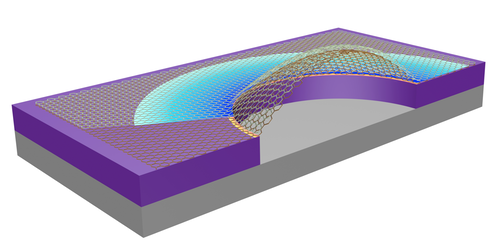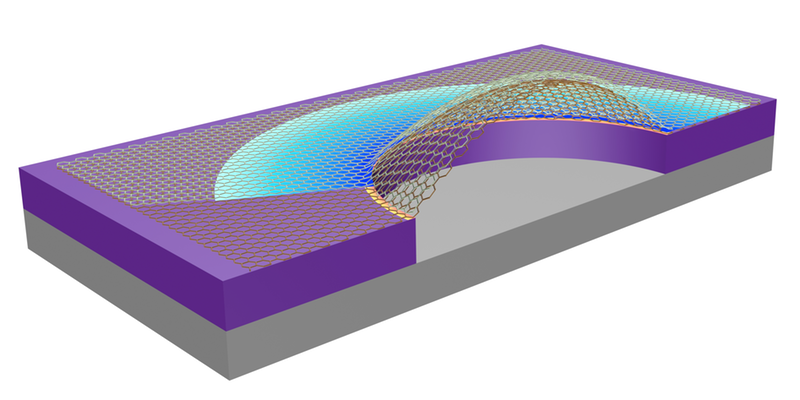Graphene Sliding on Graphene
Graphene, the single-atom-thick, sheet-like super-material of the past decade is now being used in multiple layers as part of high-strength composites and a range of electronic devices. One important challenge for this developing industry is the lack of information on the stickiness between layers of graphene or between graphene and another surface. A new experiment measured the maximum sticking force, or shear resistance, between two layers by determining the shape of the bulge produced by an air bubble blown up from beneath the surface. The analysis found that graphene layers adhere to each other very weakly—40 times less than they do to an underlying surface of silicon dioxide.
A single layer of graphene is composed of carbon atoms arranged in a two-dimensional honeycomb pattern. When stacked on top of another layer or surface, the graphene forms only a weak attachment, which is why it is often used as a lubricant [1]. Knowing precisely graphene’s stickiness is crucial for the new crop of multilayer graphene products, such as battery anodes, transistors, and displays, says Zhong Zhang from the National Center for Nanoscience and Technology (NCNST) in Beijing. For example, nanocomposites made from a combination of graphene and plastic can potentially fail if graphene layers suddenly slip away from each other.
To measure the shear resistance between two materials, one might apply a shear stress by creating a sandwich of the two and pulling the top material sideways while holding the bottom one still. The shear resistance would correspond to the force (per unit of contact area) required to start the materials slipping away from each other. Such a test is inconceivable for graphene, Zhang says, because there’s no easy way to grab and pull individual sheets. Instead, he and his collaborators developed a shear measurement technique based on a so-called blister test.
To demonstrate the method, the researchers placed a single graphene sheet on top of a surface of silicon dioxide in which several micrometer-sized holes had been etched. The team was able to increase the air pressure inside the holes, causing the graphene “lid” to bulge upward. This bulging created an inward pull on the sheet, which was countered by the sticking force of the sheet to the surface. In order to study graphene-graphene stickiness, the researchers performed two sets of experiments: one with monolayer graphene and the other with bilayer graphene. In both cases, the bulge shape was measured with an atomic force microscope, and the amount of stretching in the carbon bonds was determined by recording the frequency shift in laser light scattered off the graphene surface (Raman spectroscopy technique).
The data showed that—for an equal bulge shape—the bilayer graphene exhibited a larger region of stretched atomic bonds beyond the dome than did the monolayer case. The explanation is that more carbon atoms get pulled inward by the bulge when they feel a weaker attachment to the layer below—as is the case for graphene on graphene. The team measured the change in the stretching area with increasing air pressure and determined a value of 40 kilopascals for the shear resistance between graphene layers with so-called AB-stacking, in which the honeycomb patterns are offset.
Zhang and his colleagues imagine that their new measurement technique could be used with other 2D materials. For example, graphene can be combined with boron nitride layers to create photodetectors. By applying strain to such devices, one can potentially tune their response to light, Zhang explains, so measuring the interlayer sticking force in these hybrid materials will be important.
The work “presents an elegant and novel technique to measure interface properties between 2D layers and substrates,” says mechanical engineering professor Horacio Espinosa from Northwestern University in Evanston, Illinois. He thinks it will give researchers new opportunities for the design of devices and materials. Material scientist Roland Bennewitz from the Leibniz Institute for New Materials in Saarbrücken, Germany, applauds the work for finally providing a quantitative basis for graphene’s superior lubrication properties. “Atomistic modeling can now be benchmarked against a reliable experimental result, and the surprising effectiveness of graphene in lubrication can be better understood,” Bennewitz says.
This research is published in Physical Review Letters.
–Michael Schirber
Michael Schirber is a Corresponding Editor for Physics Magazine based in Lyon, France.
References
- D. Berman, S. A. Deshmukh, S. K. R. S. Sankaranarayanan, A. Erdemir, and A. V. Sumant, “Macroscale Superlubricity Enabled by Graphene Nanoscroll Formation,” Science 348, 1118 (2015).





